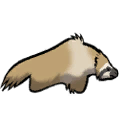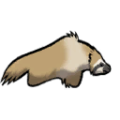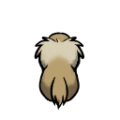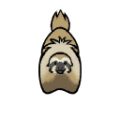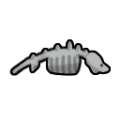Megasloth
Megasloth
A giant, solitary herbivore with two giant claws for warding off threats. Long extinct after being wiped out by the natives of Earth's American continent, the megasloth was later brought back using advanced cloning and artificial gestators. Its thick hide is exceptionally strong and insulating, and makes a great leather for cold-weather clothing. It is peaceful if left alone, but will shred anyone who disturbs it with its giant claws.
Base Stats
- Type
- Animal
- Flammability
- 70%
Pawn Stats
- Combat Power
- 280
- Move Speed
- 4.8 c/s
- Health Scale
- 360% HP
- Body Size
- 4
- Mass - Baby
- 48 kg
- Mass - Juvenile
- 120 kg
- Mass - Adult
- 240 kg
- Carrying Capacity
- 300
- Filth Rate
- 24
- Hunger Rate
- 1.6 Nutrition/Day
- Diet
- herbivorous
- Life Expectancy
- 20 years
- Coastal Animal
- false
- Manhunter Chance
- 50%
- Manhunter Chance (Taming)
- 30%
- Trainable Intelligence
- Advanced
- Available Training
- Guard, Attack, Rescue, Haul
- Wildness
- 97%
- Minimum Handling Skill
- 10
- Mate Interval
- 12 hours
- Maturity Age
- 0.667 years (40 days)
- Juvenile Age
- 0.333 years (20 days)
- Toxic Resistance
- 50%
- Toxic Environment Resistance
- 0%
- Comfortable Temp Range
- -55 °C – 40 °C (-67 °F – 104 °F)
Production
- Meat Yield
 560 megasloth meat
560 megasloth meat- Leather Yield
 160 heavy fur
160 heavy fur- Wool Amount
 200 megasloth wool
200 megasloth wool- Shearing Interval
- 20 days
- Gestation Period
- 13.32 days
- Offspring Per Birth
- 1
Melee Combat
- Attack 1
- Front left paw
21 dmg (Scratch)
31 % AP
2 second cooldown - Attack 2
- Front right paw
21 dmg (Scratch)
31 % AP
2 second cooldown - Attack 3
- Teeth
22 dmg (Bite)
33 % AP
2.6 second cooldown
0.7 chance factor - Attack 4
- Head
15 dmg (Blunt)
22 % AP
2 second cooldown
0.2 chance factor - Average DPS
- 6.1256
- tradeTags
- AnimalUncommon, AnimalFighter
The megasloth is a giant, ancient sloth. Megasloths can be found in temperate forests, temperate swamps, arid shrublands, boreal forests, cold bogs, tundra, ice sheets, and glacial plains![]() .
.
Acquisition[edit]
Megasloths can be found in temperate forests, temperate swamps, arid shrublands, boreal forests, cold bogs, tundra, ice sheets, and glacial plains![]() . They can either be tamed by a handler or self-tame in a random event.
. They can either be tamed by a handler or self-tame in a random event.
Megasloths can be bought and sold in other faction bases and from exotic goods traders. Megasloths purchased from traders will be already tamed.
Summary[edit]
Tamed megasloth can be sheared for ![]() 200 Megasloth wool (
200 Megasloth wool (![]() 324) every 20 days for 1,700 ticks (28.33 secs) of work. Note that yield and shearing time are modified by the shearer's Animal Gather Yield and Animal Gather Speed respectively.
324) every 20 days for 1,700 ticks (28.33 secs) of work. Note that yield and shearing time are modified by the shearer's Animal Gather Yield and Animal Gather Speed respectively.
Analysis[edit]
Although being a "sloth", it actually has a slightly faster movement speed than a human. Attacking one is quite dangerous and taming one will require both high skill and considerable risk. It is the second hardest animal after the Thrumbo to tame, and with most skill levels, the manhunter chance is higher than the taming chance. Wounding then saving the megasloth, or waiting for an inspiration is the recommended way to tame one. It should be noted the Megasloth has the highest filth of any animal in the game, tying the elephant for first place.
Early armor[edit]
Megasloths can spawn from the very start of the game, and provide large quantities of meat and heavy fur, the 5th most protective textile in the game. The protection offered by a heavy fur duster can provide a significant buff to the combat staying power of your pawns at a time where they're most vulnerable, especially if a skilled crafter is available. Hunting megasloths this early is not simple however, as they are faster than most pawns, and have high DPS and large health pools.
However by kiting it with one pawn as the others attack, trading off colonists for it to target as needed, and allowing it to bleed out if necessary, both Crashlanded and Lost Tribe starts can successfully hunt them from day one. Avoid wearing encumbering armor, and ideally use any pawns with move speed bonuses, such as those with the jogger trait or fast runner![]() gene, as the primary bait.
gene, as the primary bait.
As an attack animal[edit]
If it can be tamed, it makes for a good attack or damage soak animal. Compared to other bulky attack animals, it is joint second in health and second highest in DPS, despite only eating as much as a human colonist.
| Animal | Health Scale | DPS | Move Speed | Hunger rate | Training Decay |
|---|---|---|---|---|---|
| Thrumbo | 8 | 6.882 | 5.5 | 2.8 | 6.1 |
| Megasloth | 3.6 | 6.126 | 4.8 | 1.6 | 6.2 |
| Elephant | 3.6 | 5.816 | 4.8 | 2.57 | 7.5 |
| Rhinoceros | 3.5 | 5.481 | 5 | 1.71 | 6.6 |
| Bear | 2.5 | 5.375 | 4.6 | 0.56 | 7.2 |
As attack and hauling animals, megasloths face heavy competition with elephants. Elephants have less wildness, which means they are easier to train and need to be trained less often. In addition, elephants are pack animals, and won't go manhunter on a failed taming attempt. However, elephants can only be found in tropical rainforests, tropical swamps, and arid shrublands. They eat more food than megasloths, but as grass is free, this usually isn't a problem.
Note that megasloths are the only combat animal that produces wool. All other wool-producing animals are pen animals and cannot be used in combat.
Wool[edit]
Megasloths produce megasloth wool, though they are the worst animal for wool quantity per nutrition consumed. 3 alpacas eat less than 1 megasloth, and produce wool at ![]() 13.5 alpaca wool per day. A megasloth produces
13.5 alpaca wool per day. A megasloth produces ![]() 10 wool per day. Biomes that provide adequate grazing make this consideration irrelevant however.
10 wool per day. Biomes that provide adequate grazing make this consideration irrelevant however.
Megasloths are theoretically the most work efficient animal for wool, however, since megasloths are not pen animals, they need to be re-trained constantly. This is less of a concern when training is already accounted for in its role as a combat animal, as all combat animals require training, but even there it consumes more time than others. Combined with their difficulty to tame in the first place, their wool is usually a secondary consideration unless its insulative properties are desperately needed.
As compensation, megasloth wool insulates well against the cold, being the 2nd best textile for cold protection. Unlike their fur, megasloth wool is not physically protective - while significantly superior to all other wools in that regard, it places slightly worse than plainleather when compared to textiles as a whole.
Training[edit]
This animal can be trained as follows:
| | |
| | |
| | |
| |
*As of version 1.1.2610, all animals can be tamed. The percentage of likelihood of success depends on factors such as the Animals Wildness Percentage, Pawn Handling Skill, and others. More information can be found on the animals page.
Health[edit]
The body part table is collapsed due to length. Expand to view.
| Part Name | Health | Quantity | Coverage[1] | Target Chance[2] | Subpart of | Internal | Capacity[3] | Effect if Destroyed/Removed |
|---|---|---|---|---|---|---|---|---|
| Body | 144 | 1 | 100% | 21% | N/A[4] | - | Death | |
| Tail | 36 | 1 | 7% | 7% | Body | - | - | |
| Spine | 90 | 1 | 3% | 3% | Body | Moving |
−100% Moving[5] | |
| Stomach | 72 | 1 | 3% | 3% | Body | Digestion |
−50% Digestion | |
| Heart | 54 | 1 | 3% | 3% | Body | Blood Pumping |
Death | |
| Lung | 54 | 2 | 3% | 3% | Body | Breathing |
−50% Breathing. Death if both lost. | |
| Kidney | 54 | 2 | 3% | 3% | Body | Blood Filtration | −50% Blood Filtration. Death if both lost. | |
| Liver | 72 | 1 | 3% | 3% | Body | Digestion |
Death | |
| Neck | 90 | 1 | 20% | 5% | Body | Eating Talking Breathing |
Death | |
| Head | 90 | 1 | 75% | 2.25% | Neck | - | Death | |
| Skull | 90 | 1 | 25% | 1.125% | Head | - | Cannot be destroyed Increasing Pain based on damage. | |
| Brain | 36 | 1 | 70% | 2.625% | Skull | Consciousness |
Death Damage always results in scarring. | |
| Eye | 36 | 2 | 12% | 1.8% | Head | Sight |
−25% Sight. −100% if both lost. Damage always results in scarring. 0% Hit Chance against Blunt damage. | |
| Ear | 43.2 | 2 | 8% | 1.2% | Head | Hearing |
−25% Hearing. −100% if both lost. | |
| Nose | 36 | 1 | 10% | 1.5% | Head | - | - | |
| AnimalJaw | 36 | 1 | 10% | 1.5% | Head | Manipulation |
−100% Manipulation. Can no longer use Bite attack. | |
| Front Leg | 108 | 2 | 7% | 5.95% | Body | Moving |
−25% Moving. −50% if both lost. Can no longer use paw attack.[6] | |
| Front Paw | 36 | 2 | 15% | 1.05% | Front Leg | Moving |
−25% Moving. −50% if both lost. Can no longer use paw attack. | |
| Rear Leg | 108 | 2 | 7% | 5.95% | Body | Moving |
−25% Moving. −50% if both lost. | |
| Rear Paw | 36 | 2 | 15% | 1.05% | Rear Leg | Moving |
−25% Moving. −50% if both lost. |
- ↑ Coverage determines the chance to hit this body part. It refers to the percentage of the super-part that this part covers, before its own sub-parts claim their own percentage. For example, if the base coverage of the super-part is 100%, and the coverage of the part is 20%, 20% of hits would hit the part, and 80% the super-part. If the part had its own sub-part with 50% coverage, the chances would be 10% sub-part, 10% part, 80% super part.
- ↑ Target Chance is the actual chance for each part to be be selected as the target when each part's coverage has been taken into account(I.E. Neck covers 7.5% of Torso but Head covers 80% of Neck so it actually has only a 1.5% chance to be selected). This is not pure hit chance, as different damage types propagate damage in different ways. See that page for details.
- ↑ Note that capacities can affect other capacities in turn. Only the primary effect is listed. See specific pages for details.
- ↑ This is the part that everything else connects to to be considered 'connected'.
- ↑ If Moving drops below 16% a pawn cannot move.
- ↑ A Scratch attack that varies from animal to animal. Each front paw allows one attack.
Attack table
| Attack (Damage type) |
DPS[1] (Post Hit Chance)[2] |
Dam. | Cool. | AP | Selection chance[3] | |
|---|---|---|---|---|---|---|
| Average | 9.88 (6.13) |
- | - | 31.5% | - | |
| Front left paw (Scratch) |
10.5 (6.51) |
21 | 2s | 31% | 37.5% | |
| Front right paw (Scratch) |
10.5 (6.51) |
21 | 2s | 31% | 37.5% | |
| Teeth (Bite) |
8.46 (5.25) |
22 | 2.6s | 33% | 25% | |
| Head (Blunt) |
7.5 (4.65) |
15 | 2s | 22% | 0% | |
- ↑ Note: This is the actual base average derived from the melee verb system updated in 1.1.2610, it may sometimes disagree with the listed value in the in-game infobox.
It may also change depending on the stats and the melee verbs available to the pawn. - ↑ Assuming a melee hit chance of 62%
- ↑ Chance for attack to be selected. It may change depending on the melee verbs available to the pawn.
Gallery[edit]
Trivia[edit]
Megasloths are based on the pre-historic sloth megatherium.[1]
Version history[edit]
- 0.16.1393 - Renamed from Megatherium to Megasloth.
References[edit]
- ↑ "Yes, this is the animal that's in the game. Its real name is megatherium." - Tynan Sylvester, Reddit comment.
